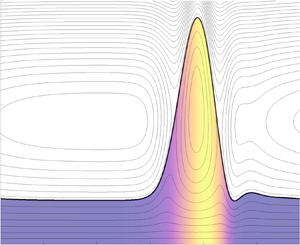JFM Rapids
On the role of the Prandtl number in convection driven by heat sources and sinks
-
- Published online by Cambridge University Press:
- 04 August 2020, R1
-
- Article
- Export citation
Near-resonant instability of geostrophic modes: beyond Greenspan's theorem
-
- Published online by Cambridge University Press:
- 05 August 2020, R2
-
- Article
-
- You have access
- Open access
- HTML
- Export citation
Parametrically forced stably stratified flow in a three-dimensional rectangular container
-
- Published online by Cambridge University Press:
- 05 August 2020, R3
-
- Article
- Export citation
Separation scaling for viscous vortex reconnection
-
- Published online by Cambridge University Press:
- 06 August 2020, R4
-
- Article
- Export citation
Ambiguity in mean-flow-based linear analysis
-
- Published online by Cambridge University Press:
- 06 August 2020, R5
-
- Article
- Export citation
Café latte: spontaneous layer formation in laterally cooled double diffusive convection
-
- Published online by Cambridge University Press:
- 11 August 2020, R6
-
- Article
-
- You have access
- Open access
- HTML
- Export citation
Scaling of rough-wall turbulence by the roughness height and steepness
-
- Published online by Cambridge University Press:
- 11 August 2020, R7
-
- Article
- Export citation
A numerical approach for fluid deformable surfaces
-
- Published online by Cambridge University Press:
- 12 August 2020, R8
-
- Article
-
- You have access
- Open access
- HTML
- Export citation
Focus on Fluids
Ricocheting inclined layer convection states
-
- Published online by Cambridge University Press:
- 13 August 2020, F1
-
- Article
-
- You have access
- HTML
- Export citation
JFM Papers
On the scaling of the instability of a flat sediment bed with respect to ripple-like patterns
-
- Published online by Cambridge University Press:
- 04 August 2020, A1
-
- Article
-
- You have access
- Open access
- HTML
- Export citation
Resolvent-based optimal estimation of transitional and turbulent flows
-
- Published online by Cambridge University Press:
- 31 July 2020, A2
-
- Article
- Export citation
Near-field internal wave beams in two dimensions
-
- Published online by Cambridge University Press:
- 31 July 2020, A3
-
- Article
- Export citation
Swimming with swirl in a viscoelastic fluid
-
- Published online by Cambridge University Press:
- 31 July 2020, A4
-
- Article
- Export citation
Sound propagation using an adjoint-based method
-
- Published online by Cambridge University Press:
- 31 July 2020, A5
-
- Article
- Export citation
Bound on the drag coefficient for a flat plate in a uniform flow
-
- Published online by Cambridge University Press:
- 04 August 2020, A6
-
- Article
- Export citation
Nonlinear dynamics of two-layer channel flow with soluble surfactant below or above the critical micelle concentration
-
- Published online by Cambridge University Press:
- 04 August 2020, A7
-
- Article
- Export citation
Cox–Voinov theory with slip
-
- Published online by Cambridge University Press:
- 03 August 2020, A8
-
- Article
-
- You have access
- Open access
- HTML
- Export citation
On quasi-steady boundary-layer separation in supersonic flow. Part 2. Downstream moving separation point
-
- Published online by Cambridge University Press:
- 03 August 2020, A9
-
- Article
- Export citation
Linear feedback control of invariant solutions in channel flow
-
- Published online by Cambridge University Press:
- 05 August 2020, A10
-
- Article
- Export citation
Spectral proper orthogonal decomposition and resolvent analysis of near-wall coherent structures in turbulent pipe flows
-
- Published online by Cambridge University Press:
- 12 August 2020, A11
-
- Article
- Export citation







































































